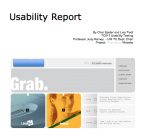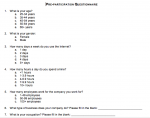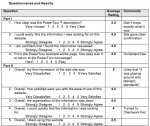SITE X (usability report)
 Usability Report
As part of a graduate student project, Lisa Tiedt and I designed and conducted a benchmark exploratory usability test for a design agency. It focused on identifying concerns that would prevent users from seeking further information about the target company. The goal was it to uncover user concerns, problems, and mistaken assumptions with respect to navigation and terminology. We also tested the content and how it would influence a potential client’s impression of the target agency.
Usability Report
As part of a graduate student project, Lisa Tiedt and I designed and conducted a benchmark exploratory usability test for a design agency. It focused on identifying concerns that would prevent users from seeking further information about the target company. The goal was it to uncover user concerns, problems, and mistaken assumptions with respect to navigation and terminology. We also tested the content and how it would influence a potential client’s impression of the target agency.
 Pre-participant Questionnaire
The questionnaire screened for two final participants that aligned with the target audience and matched the following requirements:
• Purchase decision maker in a sales or marketing position
• Employed by company of 50 employees or more
• Has no prior experience with the target agency
Pre-participant Questionnaire
The questionnaire screened for two final participants that aligned with the target audience and matched the following requirements:
• Purchase decision maker in a sales or marketing position
• Employed by company of 50 employees or more
• Has no prior experience with the target agency
 Test Planning Matrix
We created a matrix to track: questions, tasks, materials, type of evidence, and for data, the type of answers, how to collect and how to analyze
Test Planning Matrix
We created a matrix to track: questions, tasks, materials, type of evidence, and for data, the type of answers, how to collect and how to analyze
 Usability Lab
The study took place in the University of Washington’s LUTE. Data collection included video, questionnaires, and interviews.
Usability Lab
The study took place in the University of Washington’s LUTE. Data collection included video, questionnaires, and interviews.
 Test Methods & Procedures
Participants went through 10 tasks using think-aloud protocol. After they completed all tasks, they filled out the questionnaire. We followed with an interview to discuss their answers and collect comments.
Test Methods & Procedures
Participants went through 10 tasks using think-aloud protocol. After they completed all tasks, they filled out the questionnaire. We followed with an interview to discuss their answers and collect comments.
 Measures and Questionnaire Results
The Questionnaire Results capture a numerical rating and user comments. Measures for the study were:
1. Whether a user completed a task.
2. The amount of time to complete the task, if task was completed.
3. How users went about completing each task (e.g. navigational path).
4. What happened when they tried to do each task.
5. Think aloud protocol. Verbalizations they made during each task gave us insight into task errors and problems with the UI.
6. What problems, if any, they encountered.
7. Users answers on the questionnaires.
8. Comments made during the post-questionnaire interview.
Measures and Questionnaire Results
The Questionnaire Results capture a numerical rating and user comments. Measures for the study were:
1. Whether a user completed a task.
2. The amount of time to complete the task, if task was completed.
3. How users went about completing each task (e.g. navigational path).
4. What happened when they tried to do each task.
5. Think aloud protocol. Verbalizations they made during each task gave us insight into task errors and problems with the UI.
6. What problems, if any, they encountered.
7. Users answers on the questionnaires.
8. Comments made during the post-questionnaire interview.
This entry was posted on Monday, July 30th, 2012 at 3:24 pm. It is filed under UX Design, ux portfolio.
You can follow any responses to this entry through the RSS 2.0 feed.
 Usability Report
As part of a graduate student project, Lisa Tiedt and I designed and conducted a benchmark exploratory usability test for a design agency. It focused on identifying concerns that would prevent users from seeking further information about the target company. The goal was it to uncover user concerns, problems, and mistaken assumptions with respect to navigation and terminology. We also tested the content and how it would influence a potential client’s impression of the target agency.
Usability Report
As part of a graduate student project, Lisa Tiedt and I designed and conducted a benchmark exploratory usability test for a design agency. It focused on identifying concerns that would prevent users from seeking further information about the target company. The goal was it to uncover user concerns, problems, and mistaken assumptions with respect to navigation and terminology. We also tested the content and how it would influence a potential client’s impression of the target agency.
 Pre-participant Questionnaire
The questionnaire screened for two final participants that aligned with the target audience and matched the following requirements:
• Purchase decision maker in a sales or marketing position
• Employed by company of 50 employees or more
• Has no prior experience with the target agency
Pre-participant Questionnaire
The questionnaire screened for two final participants that aligned with the target audience and matched the following requirements:
• Purchase decision maker in a sales or marketing position
• Employed by company of 50 employees or more
• Has no prior experience with the target agency
 Test Planning Matrix
We created a matrix to track: questions, tasks, materials, type of evidence, and for data, the type of answers, how to collect and how to analyze
Test Planning Matrix
We created a matrix to track: questions, tasks, materials, type of evidence, and for data, the type of answers, how to collect and how to analyze
 Usability Lab
The study took place in the University of Washington’s LUTE. Data collection included video, questionnaires, and interviews.
Usability Lab
The study took place in the University of Washington’s LUTE. Data collection included video, questionnaires, and interviews.
 Test Methods & Procedures
Participants went through 10 tasks using think-aloud protocol. After they completed all tasks, they filled out the questionnaire. We followed with an interview to discuss their answers and collect comments.
Test Methods & Procedures
Participants went through 10 tasks using think-aloud protocol. After they completed all tasks, they filled out the questionnaire. We followed with an interview to discuss their answers and collect comments.
 Measures and Questionnaire Results
The Questionnaire Results capture a numerical rating and user comments. Measures for the study were:
1. Whether a user completed a task.
2. The amount of time to complete the task, if task was completed.
3. How users went about completing each task (e.g. navigational path).
4. What happened when they tried to do each task.
5. Think aloud protocol. Verbalizations they made during each task gave us insight into task errors and problems with the UI.
6. What problems, if any, they encountered.
7. Users answers on the questionnaires.
8. Comments made during the post-questionnaire interview.
Measures and Questionnaire Results
The Questionnaire Results capture a numerical rating and user comments. Measures for the study were:
1. Whether a user completed a task.
2. The amount of time to complete the task, if task was completed.
3. How users went about completing each task (e.g. navigational path).
4. What happened when they tried to do each task.
5. Think aloud protocol. Verbalizations they made during each task gave us insight into task errors and problems with the UI.
6. What problems, if any, they encountered.
7. Users answers on the questionnaires.
8. Comments made during the post-questionnaire interview.